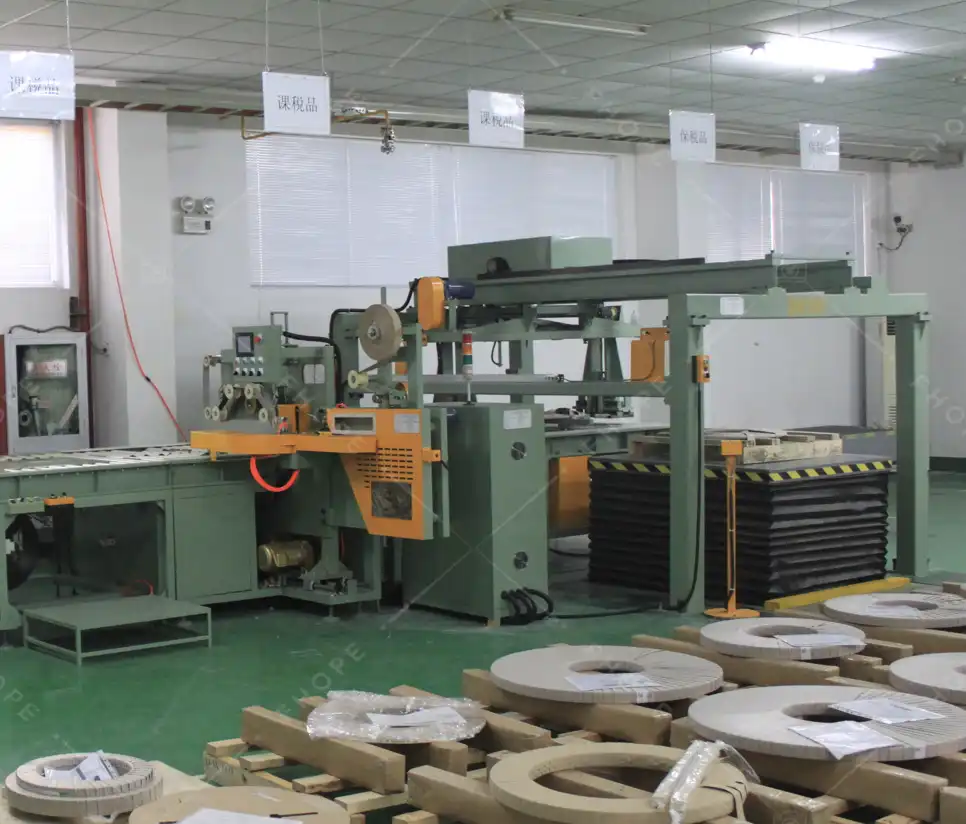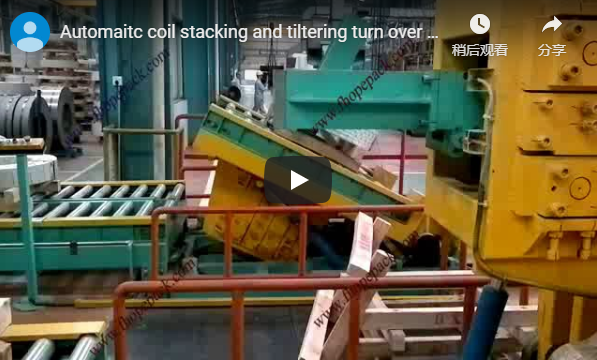Automatic Coil Stacking and Tilting Turnover Machine: Enhancing Efficiency in Material Handling
Handling heavy coils of materials like steel, aluminum, or paper presents significant logistical and safety challenges in numerous industries. Automating these processes is key to improving efficiency, safety, and product quality. The Automatic Coil Stacking and Tilting Turnover Machine represents a critical piece of equipment in modern coil processing and handling lines.
This specialized machinery automates the often complex tasks of receiving coils (typically with the eye horizontal), tilting them (usually to an eye-vertical position), and stacking them precisely for storage, transport, or further processing.

1. Operational Principle: How the Coil Stacker and Tilter Works
The typical operational sequence involves several automated steps:
- Coil Infeed: Coils are transported to the machine, often via a conveyor system (roller or chain type) or loaded directly by crane or forklift onto an input station.
- Positioning: Sensors accurately detect the coil's position, ensuring it is correctly aligned for the tilting and stacking process.
- Tilting: The core function involves a robust tilting mechanism (often hydraulically or electro-mechanically actuated) that rotates the coil, commonly by 90 degrees, from a horizontal-eye orientation to a vertical-eye orientation, or vice-versa depending on the application requirement.
- Stacking: Once tilted (if required), a stacking unit, which might involve lifting platforms, clamps, or specialized arms, carefully places the coil onto a designated stacking area or directly onto a previous coil, ensuring stability and alignment.
- Discharge: The stacked coils can then be automatically transferred to the next stage, such as a packaging line, storage area, or onto autonomous guided vehicles (AGVs).
The entire process is managed by a Programmable Logic Controller (PLC), ensuring synchronization and safety throughout the cycle.
2. Core Components and Technical Specifications
While designs vary based on application, key components typically include:
- Heavy-Duty Frame: Provides structural integrity to handle significant loads.
- Conveyor System: For automated infeed and outfeed (optional).
- Tilting Platform/Mechanism: Engineered for smooth, controlled rotation of heavy coils.
- Stacking Unit: Mechanism designed for precise vertical placement.
- Control System: PLC-based controls with a Human-Machine Interface (HMI) for operation and diagnostics.
- Sensors: Photoelectric sensors, limit switches, and load cells for positioning, sequence control, and safety.
- Safety Features: Physical guarding, light curtains, emergency stops compliant with relevant safety standards.
Typical Technical Parameters (Example Range):
- Load Capacity: 5 tons – 30+ tons
- Coil Outer Diameter (OD): 800mm – 2500mm
- Coil Width: 500mm – 2000mm
- Tilting Angle: Typically 90° (custom angles possible)
- Cycle Time: Varies significantly based on coil size and machine complexity (e.g., 60 – 180 seconds)
- Power: Dependent on scale, often 400V/50Hz or specified requirement.
3. Key Benefits in Industrial Applications
Implementing an automatic coil stacking and tilting turnover machine offers substantial advantages:
- Increased Throughput & Efficiency: Automating the handling process drastically reduces cycle times compared to manual or semi-automatic methods.
- Enhanced Worker Safety & Ergonomics: Eliminates dangerous manual handling of heavy, awkward loads, significantly reducing the risk of musculoskeletal injuries and accidents.
- Reduced Product Damage: Gentle, controlled handling minimizes the risk of coil damage such as edge deformation, telescoping, or surface scratches, preserving material quality.
- Minimized Manual Labour & Operational Costs: Reduces the need for dedicated manual labor, freeing up personnel for other tasks and lowering overall operating expenses. Contributes to a faster Return on Investment (ROI).
- Optimized Floor Space: Efficient stacking can help optimize storage density within the facility.
- Process Consistency: Automation ensures repeatable accuracy in tilting and stacking, crucial for downstream processes.
4. Application Areas and Versatility
These machines are indispensable in various sectors:
- Steel Mills and Service Centers: Handling hot/cold rolled coils, galvanized coils, stainless steel coils.
- Aluminum Processing Plants: Managing sensitive aluminum coils where surface quality is paramount.
- Metal Stamping Facilities: Feeding coils to press lines.
- Paper Mills: Handling large, heavy paper rolls.
- Cable and Wire Manufacturing: Managing large spools or reels.
Machines can often be customized to handle specific coil dimensions, weights, and even different material types.
5. Integration and Automation Capabilities
A key strength of modern coil stackers and tilters is their ability to integrate seamlessly into larger automated production or logistics systems. They can communicate with:
- Upstream Equipment: Slitting lines, rolling mills.
- Downstream Equipment: Automatic coil packing lines, strapping machines, AGVs, automated storage and retrieval systems (AS/RS).
- Manufacturing Execution Systems (MES) / Enterprise Resource Planning (ERP): For production tracking, data logging, and overall plant management via protocols like OPC UA or Profinet.
This level of integration is vital for achieving Industry 4.0 objectives in material handling.
6. Experience Sharing: Operational Considerations and Best Practices
From an operational perspective, maximizing the value of these machines involves:
- Regular Maintenance: Adhering to the manufacturer's recommended maintenance schedule for hydraulics, pneumatics, sensors, and mechanical components is crucial for reliability and longevity.
- Operator Training: Ensuring personnel are thoroughly trained on machine operation, safety procedures, and basic troubleshooting enhances both safety and efficiency.
- Safety Protocol Adherence: Regularly verifying safety features (E-stops, light curtains, guarding) are functional and that operators follow safe work practices is non-negotiable. Compliance with local and international safety standards (e.g., CE marking in Europe) is essential.
- Process Optimization: Continuously evaluating the machine's cycle time and integration points can reveal opportunities for further efficiency gains.
Conclusion
The Automatic Coil Stacking and Tilting Turnover Machine is more than just handling equipment; it is a strategic asset for industries dealing with large coils. By automating critical handling steps, it delivers significant improvements in productivity, operational safety, product integrity, and overall cost-effectiveness, making it a cornerstone of modern, efficient material flow management.


